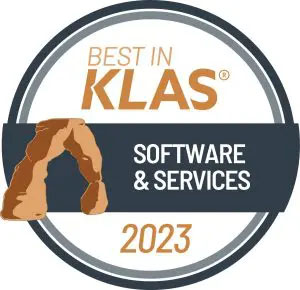
As the most influential healthcare technology tradeshow of the year, the HIMSS Global Health Conference & Exhibition is a pivotal event for anyone in the digital health space. But with more than 700 vendors, how can you ensure that you’re making the most of your time on the show floor?
In this EI Connection Blog Q&A, we connected with Fujifilm Regional Director of Enterprise Imaging Sales Mike Haddad to learn what sets Fujifilm apart in the market and identify the informatics innovations that are a must-see at booth #2801.
What do you think show attendees are most excited to see from Fujifilm during HIMSS 2023?

Fujifilm is known for continuously advancing its enterprise imaging offerings to help meet current and future market needs. We pioneered web-based PACS more than 30 years ago, followed by the introduction of server-side engineering for our full portfolio more than 8 years ago. We also continue to lead the market with our vendor-neutral archive and optimize our AI platform to enhance diagnostic accuracy and efficiency.
This year at HIMSS, attendees want to see the culmination of that innovation. Our enterprise PACS Synapse® 7x gives today’s healthcare providers a single, server-side platform that supports nearly all enterprise imaging needs. It converges radiology, mammography, cardiology, pathology, and specialty department imaging and datasets on one diagnostic viewer. The solution also natively offers more than 50 advanced visualization applications, supports AI-driven workflows, and has our four-time “Best in KLAS” Synapse VNA at the core.
HIMSS is one of the biggest healthcare IT tradeshows of the year, with more than 700 exhibitors. What differentiates Fujifilm from its competitors in the medical informatics space?
Fujifilm has always been, and continues to be, dedicated to medical informatics. As other vendors move away from the space, we continue to invest in strategic growth opportunities. It’s really a core competency that we’re known for. For example, we recently added digital pathology to our portfolio, which is a proof point of our ability to innovate in a new area of imaging informatics.
Synapse PACS and VNA, arguably two of the foundational elements in Fujifilm’s enterprise imaging portfolio, both received 2023 Best in KLAS recognitions. What do you think allows Fujifilm to continuously receive these accolades?

What really stands out about KLAS is that it’s solely based on end-user feedback. Customer collaboration has always been at the heart of Fujifilm’s business model. We place such an emphasis on truly listening to our customers’ wants and needs. Rather than building solutions we think are of value, we rely on their involvement to develop solutions that meet their needs both now and in the future.
Our Synapse 7 PACS architecture is a prime example of that. Our customer North Memorial Health needed a cardiovascular information system (CVIS) that supported comprehensive cardiology assessments and reporting but had an enterprise imaging foundation. Our team worked with North Memorial Health to bring that concept to life. We leveraged the investments we’d made in our radiology PACS and applied them to cardiology. The unification of our radiology and cardiology PACS on one platform through Synapse 7 provides those specialized tool sets and workflows, while enhancing cross-departmental imaging access and collaboration. It’s instances like this that allow us to remain Best in KLAS. You can read more about our collaboration with North Memorial here.
Cloud continues to be a major focus for today’s healthcare facilities. If you could relay one message to the market about Fujifilm’s Synapse Cloud Services, what would it be?
Fujifilm has extensive experience in cloud deployment. We have maintained two of our own cloud locations since 2006. Our experience also allows us to easily and quickly bring our technology to third-party cloud hosting solutions.
Fujifilm’s mission is to “never stop innovating for a healthier world.” A primary example of that is the introduction of new informatics innovations, such as digital pathology and analytics, to the Synapse portfolio. What opportunities do these additions bring to Synapse customers?
Fujifilm’s informatics innovation and strategic market investments are what have cemented us as a market leader for more than 30 years. Those elements also drove our digital pathology initiative. Studies have shown that the digital pathology market could be worth $640 million by 2025, and yet the specialty has been slow to fully adopt a digital workflow. Fujifilm saw this as an opportunity to lead pathology’s digital transformation. Our portfolio is designed for imaging interoperability, cross-departmental collaboration, and workflow optimization. Bringing these benefits to pathology is just another way that we fully support informatics across the entire enterprise.
The introduction of analytics was a natural progression for Synapse. As an informatics business, we know that knowledge is power. Our analytics offering allows our customers to really drill down into current and predictive business trends. That includes procedure volumes, lab operation efficiency, and diagnostic accuracy assessments. Based on these insights, customers can make more-informed business decisions that can improve patient outcomes and drive ROI. We expect both digital pathology and analytics to be of significant interest to HIMSS attendees this year.